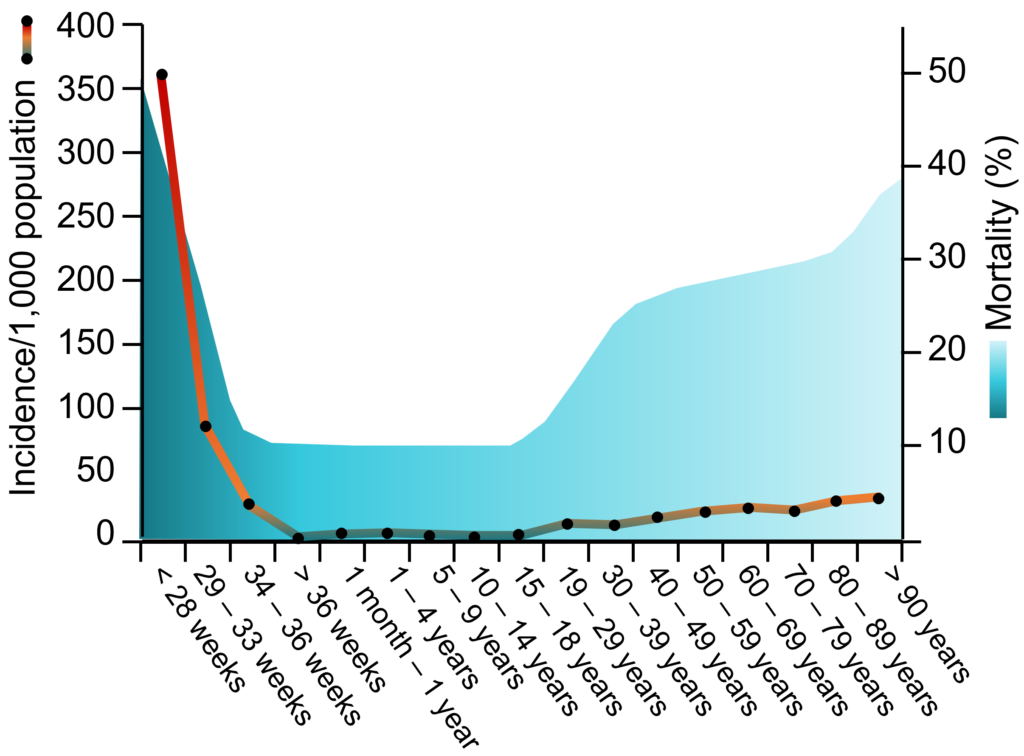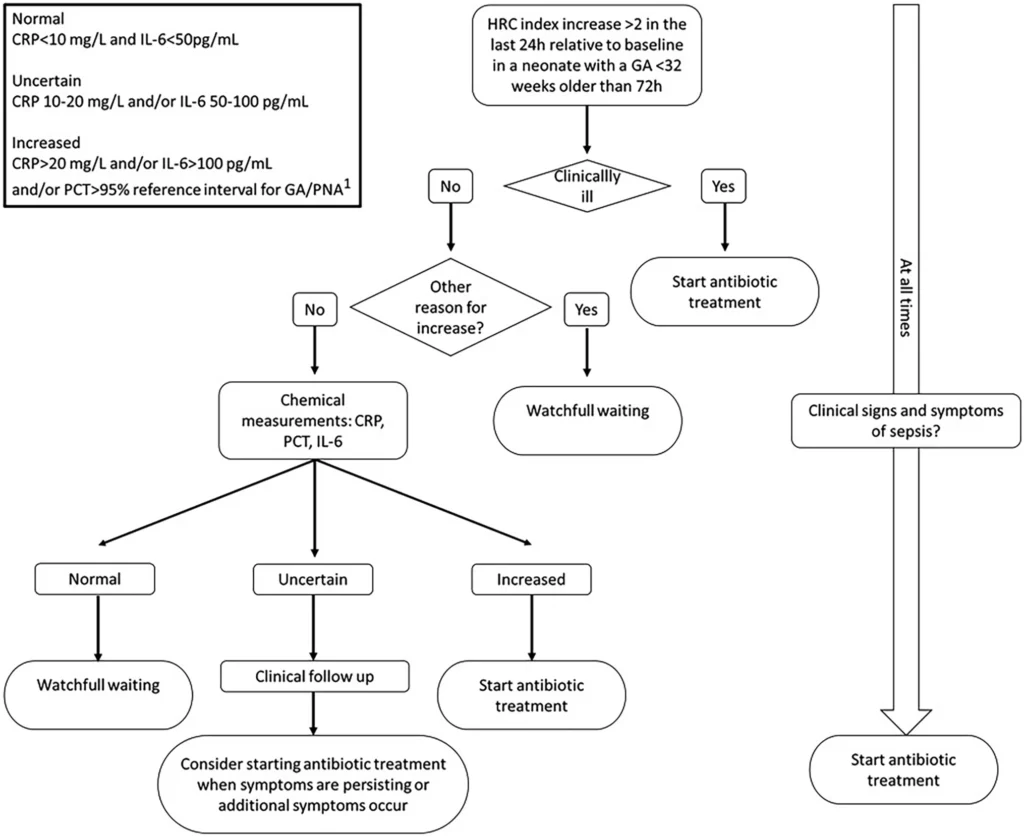Sepsis

WHAT IS SEPSIS?
Sepsis
Sepsis is defined as a “life-threatening organ dysfunction caused by a dsyregulated host response to infection” 1. Sepsis arises when the immune response to an infection causes injury to the body’s own tissues and organs. It can be caused by a range of pathogens, however, bacterial infections representing the majority of cases. It is especially prevalent in immunocompromised, preterm and elderly populations 2. Sepsis is the most expensive in-hospital health-care problem in the USA with costs for treatment exceeding $20 billion annually 3.
Detection and Diagnosis
Admission characteristics differ between preterm neonates and adults populations
Sepsis in preterm neonates can be classified in two different categories, being early- and late-onset sepsis (EOS and LOS). EOS is defined as sepsis developing within the first 72 hours of life 4. Early detection of EOS and LOS might require different strategies, however, in both cases the patient is usually already admitted to the NICU. This opens up possibilities for novel methods for early detection by using biochemical markers. Pre-diagnostic data will be available and could be used to find the optimal patient specific treatment strategy.
For adults the admission characteristics are very different. Approximately half of the sepsis patients are being admitted from outside the hospital, mostly through the emergency department, the rest is coming from within the hospital 5. In this case patients present in a later stage where clinical symptoms are already present. Prompt diagnosis and a patient specific treatment strategy are required despite the limited data that is available.
Neonates
Early detection of sepsis is difficult and remains one of the reasons this disease is so deadly. Every hour that antibiotic treatment is delayed a 10% increase in mortality has been observed 6. In patients already admitted to the NICU heart rate variability (HRV) monitoring can be used to screen for early detection of infection and sepsis 7. If the changes in HRV cannot be explained a biochemical marker panel that includes CRP, PCT and IL-6 can be measured in blood. Based on these results sepsis can be diagnosed and antibiotic treatment will be started.
Treatment and Drug Related Problems
Unexpected undesirable effects and potential harm to the patients health due to drug therapy are called drug related problems (DRPs). Adverse drug events (ADEs) are actual harmful events that occur in patients and can result in end-organ damage or death. DRPs can turn into ADEs if not adequately addressed in time. DRPs can be classified according to the Pharmaceutical Care Network Europe (PCNE) Foundation Classification. These statistics give insight in the extend en causes of DRPs.
Neonates
Fast development and growth of the neonates and physiological immaturity are thought to be some of the reasons for the high frequency of DRPs in neonates. Additionally, almost 80% of drugs have not been studied in children. It has been recorded that up to 60% of neonates experience one or more DRPs. Most common problems are a sub-optimal effect caused by inappropriate dose selection. Anti-infectives are the medication class most often involved in DRPs 9. These numbers depend on the region of the world as well as the degree of cooperation between physicians and pharmacists in the specific hospital.

Adults
About 70% of adult ICU patients have been reported to experience DRPs 10, 11. Again the main cause of DRP has been drug dosing. Anti-infectives also make up the largest class of drugs involved with DRP in this group.

References
[1] Singer, M. et al. The Third International Consensus Definitions for Sepsis and Septic Shock (Sepsis-3). JAMA vol. 315 801 (2016).
[2] Wynn, J. L. & Wong, H. R. Pathophysiology of Neonatal Sepsis. Fetal and Neonatal Physiology 1536-1552.e10 (2017).
[3] Martin, G. S., Mannino, D. M., Eaton, S. & Moss, M. The Epidemiology of Sepsis in the United States from 1979 through 2000. New England Journal of Medicine vol. 348 1546–1554 (2003).
[4] Wynn, J. L. Defining neonatal sepsis. Current Opinion in Pediatrics vol. 28 135–140 (2016).
[5] Sakr, Y. et al. Sepsis in Intensive Care Unit Patients: Worldwide Data From the Intensive Care over Nations Audit. Open Forum Infectious Diseases vol. 5 (2018).
[6] Schmatz, M. et al. Surviving Sepsis in a Referral Neonatal Intensive Care Unit: Association between Time to Antibiotic Administration and In-Hospital Outcomes. The Journal of Pediatrics vol. 217 59-65.e1 (2020).
[7] Kurul, Ş. et al. Introducing heart rate variability monitoring combined with biomarker screening into a level IV NICU: a prospective implementation study. European Journal of Pediatrics vol. 181 3331–3338 (2022).
[8] Bodmann, K.-F., Höhl, R., Krüger, W., Grabein, B. & Graninger, W. Kalkulierte parenterale Initialtherapie bakterieller Infektionen: Sepsis. GMS Infectious Diseases; 8:Doc09 (2020)
[9] Leopoldino, R. D., Santos, M. T., Costa, T. X., Martins, R. R. & Oliveira, A. G. Drug related problems in the neonatal intensive care unit: incidence, characterization and clinical relevance. BMC Pediatrics vol. 19 (2019).
[10] Li, X. et al. Drug-Related Problems Identified During Pharmacy Intervention and Consultation: Implementation of an Intensive Care Unit Pharmaceutical Care Model. Frontiers in Pharmacology vol. 11 (2020).
[11] Albayrak, A., Başgut, B., Bıkmaz, G. A. & Karahalil, B. Clinical pharmacist assessment of drug-related problems among intensive care unit patients in a Turkish university hospital. BMC Health Services Research vol. 22 (2022).
Talk to us
Have any questions? We are always open to talk about collaborations, new projects and other opportunities.

